Lapu-Lapu
Lapulapu[2][3][4] (based on Çilapulapu;[5] Baybayin: , Abecedario: Lápú-Lápú) (fl. 1521), also known as Lapu-Lapu, Si Lapulapu,[6] Salip Pulaka,[7] Cali Pulaco,[8] and Lapulapu Dimantag,[9] was a ruler of Mactan in the Visayas. Modern Philippine society regards him as the first Filipino hero because he was the first native to resist imperial Spanish colonization. He is best known for the Battle of Mactan that happened at dawn on April 27, 1521, where he and his soldiers defeated Portuguese explorer Ferdinand Magellan, who was killed in battle.[10] Magellan's death ended his voyage of circumnavigation and delayed the Spanish occupation of the islands by over forty years until the expedition of Miguel López de Legazpi in 1564. Monuments of Lapulapu have been built in Cebu and Manila, while the Philippine National Police and the Bureau of Fire Protection use his image as part of their official seals.
| Lapulapu | |
|---|---|
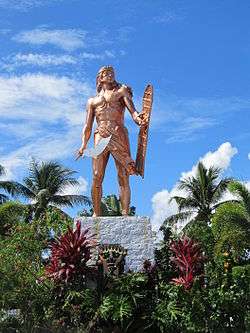 The statue of Lapulapu on Mactan Island | |
| 1st Datu of Mactan | |
| Reign | fl. 1521-fl. 1542 |
| Predecessor | ? |
| Successor | Mangubat[1] |
| Born | c. 1491 Opong, Rajahnate of Sugbu |
| Died | 1542 (aged 50–51) Mactan |
Besides being a rival of Rajah Humabon of neighbouring Indianized Cebu, very little is known about the life of Lapulapu. The only existing documents about his life are those written by Antonio Pigafetta, and according to historian Resil B. Mojares, he was never seen in person by any European who left a historical record.[11] His name, origins, religion, and fate are still a matter of controversy.
Name
The historical name of Lapulapu is debated. The earliest record of his name comes from Italian diarist Antonio Pigafetta who accompanied Magellan's expedition. Pigafetta notes the names of two chiefs of the island of "Mactan", the chiefs "Zula" and Alqader alias "Çilapulapu" (note Ç).[5] In an annotation of the 1890 edition of Antonio de Morga's Sucesos de las islas Filipinas, José Rizal spells this name as "Si Lapulapu".[6] The honorific Çi or Si is from si (plural siná), an article in Philippine languages used to indicate personal names. Patanñe (1999), however, proposes that in this usage, it was derived from a corruption of the Sanskrit title Sri.[12] The Aginid chronicle calls him "Lapulapu Dimantag".[9]
The title Salip (and its variants Sarripada, Sipad, Paduka, Seri Paduka, and Salipada, etc.) is frequently used as an honorific for Lapulapu and other Visayan datus. Despite common misconception, it is not derived from the Islamic title Khalīfah (Caliph). It was derived from the Sanskrit title Sri Paduka, denoting "His Highness". The title is still used today in Malaysia as Seri Paduka.[7]
The 17th century mestizo de sangley poet Carlos Calao mentions Lapulapu under the name of "Cali Pulaco" (perhaps a misreading of the Ç used in Pigafetta's spelling) in his poem Que Dios le perdone (May God Forgive Him).[13] The name, spelled "Kalipulako", was later adopted as one of the pseudonyms of the Philippine hero, Mariano Ponce, during the Philippine Revolution.[14] The 1898 Philippine Declaration of Independence of Cavite II el Viejo, also mentions Lapulapu under the name "Rey Kalipulako de Manktan [sic]" (King Kalipulako of Mactan).[15]
In 2019, the National Quincentennial Committee, tasked with handling preparations for the 500th anniversary commemoration of Magellan's arrival, has stated that "Lapulapu" without the hyphen is the correct spelling of the Mactan ruler's name, being based on Pigafetta's original "Çilapulapu" spelling.[2]
Early life
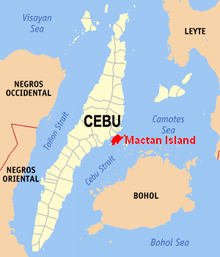
There had been many folk accounts surrounding Lapulapu’s origin. One oral tradition is that the Sugbuanons of Opong was once ruled by datu named Mangal and later succeeded by his son named Lapulapu.[16]
Another is from oral chronicles from the reign of the last king of Cebu, Rajah Tupas (d. 1565). This was compiled and written in Baybayin in the book Aginid, Bayok sa Atong Tawarik ("Glide on, Odes to Our History") in 1952 by Jovito Abellana. The chronicle records the founding of the Rajahnate of Cebu by a certain Sri Lumay (also known as Rajamuda Lumaya), who was a prince from the Hindu Chola dynasty of Sumatra. His sons, Sri Alho and Sri Ukob, ruled the neighboring communities of Sialo and Nahalin, respectively. The islands they were in were collectively known as Pulua Kang Dayang or Kangdaya (literally "[the islands] of the lady"). Sri Lumay was known for his strict policies in defending against Moro raiders and slavers from Mindanao. His use of scorched earth tactics to repel invaders gave rise to the name Kang Sri Lumayng Sugbo (literally "that of Sri Lumay's great fire") to the town, which was later shortened to Sugbo ("conflagration").[9]
Upon his death in a battle against the raiders, Sri Lumay was succeeded by his youngest son, Sri Bantug, who ruled from the region of Singhapala (literally "lion city"), now Mabolo in modern Cebu City. Sri Bantug died of a disease during an epidemic and was succeeded by his son Rajah Humabon (also known as Sri Humabon or Rajah Humabara).[9] During Humabon's reign, the region had become an important trading center. The harbors of Sugbo became known colloquially as sinibuayng hingpit ("the place for trading"), shortened to sibu or sibo ("to trade"), from which the modern name "Cebu" originates.[9]
According to the epic Aginid, this was the period in which Lapulapu (as Lapulapu Dimantag) was first recorded as arriving from "Borneo" (Sabah). He asked Humabon for a place to settle, and the king offered him the region of Mandawili (now Mandaue), including the island known as Opong (or Opon), hoping that Lapulapu's people would cultivate the land. They were successful in this, and the influx of farm produce from Mandawili enriched the trade port of Sugbo further.[9]
The relationship between Lapulapu and Humabon later deteriorated when Lapulapu turned to piracy. He began raiding merchant ships passing the island of Opong, affecting trade in Sugbo. The island thus earned the name Mangatang ("those who lie in wait"), later evolving to "Mactan".[9]
Battle of Mactan
Lapulapu was one of the two datus of Mactan before the Spanish arrived in the archipelago, the other being a certain Zula, both of whom belong to the Maginoo class. When Portuguese explorer Ferdinand Magellan arrived in the Philippines in the service of Spain, Zula was one of those who gave tribute to the Spanish king while Lapulapu refused.[17]
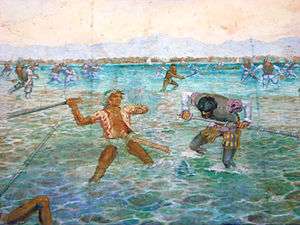
In the midnight of April 27, 1521, Magellan led a force of around sixty Spaniards and twenty to thirty war boats (karakoa) of Humabon's warriors from Cebu. They arrived in Mactan three hours before dawn. However, because of the presence of rock outcroppings and coral reefs, Magellan's ships could not land on the shores of Mactan. Their ships were forced to anchor "two crossbow flights" away from the beach. According to Antonio Pigafetta, they faced around 1,500 warriors of Lapulapu armed with iron swords,[note 1] bows, and "bamboo" spears.[note 2]
Magellan repeated his offer not to attack them if Lapulapu swore fealty to Rajah Humabon, obeyed the Spanish king, and paid tribute, which Lapulapu again rejected. At the taunting request of Lapulapu, the battle did not begin until morning. Magellan, perhaps hoping to impress Humabon's warriors with the superiority of European armor and weapons, told Humabon's warriors to remain in their balangay. Magellan and forty-nine of the heavily armored Spaniards (armed with lances, swords, crossbows, and muskets) waded ashore to meet Lapulapu's forces. They set fire to a few houses on the shore in an attempt to scare them. Instead, Lapulapu's warriors became infuriated and charged. Two Spaniards were killed immediately in the fighting, and Magellan was wounded in the leg with a poisoned arrow. He ordered a retreat, which most of his men followed except for a few who remained to protect him. However, he was recognized as the captain by the natives, whereupon he became the focus of the attack. Outnumbered and encumbered by their armor, Magellan's forces were quickly overwhelmed. Magellan and several of his men were killed, and the rest escaped to the waiting ships.[17][18]
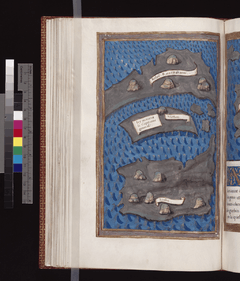
The historian William Henry Scott believes that Lapulapu's hostility may have been the result of a mistaken assumption by Magellan. Magellan assumed that ancient Filipino society was structured in the same way as European society (i.e. with royalty ruling over a region). While this may have been true in the Islamic sultanates in Mindanao, the Visayan societies were structured along a loose federation of city-states (more accurately, a chiefdom). The most powerful datu in such a federation has limited power over other member datu, but no direct control over the subjects or lands of the other datu.[7]
Thus Magellan believed that since Rajah Humabon was the "king" of Cebu, he was the king of Mactan as well. But the island of Mactan, the dominion of Lapulapu and Zula, was in a location that enabled them to intercept trade ships entering the harbor of Cebu, Humabon's domain. Thus it was more likely that Lapulapu was actually more powerful than Humabon, or at least was the undisputed ruler of Mactan. Humabon was married to Lapulapu's niece. When Magellan demanded that Lapulapu submit as his "king" Humabon had done, Lapulapu purportedly replied that: "he was unwilling to come and do reverence to one whom he had been commanding for so long a time".[7]
The Aginid chronicle also records that Humabon had actually purposefully goaded the Spaniards into fighting Lapulapu, who was his enemy at that time. However, the men of Humabon who accompanied Magellan did not engage in battle with Lapulapu, though they helped with recovering the wounded Spaniards. Humabon later poisoned and killed twenty-seven Spanish sailors during a feast. According to the Aginid, this was because they had started raping the local women. It was also possibly to aid Magellan's Malay slave interpreter, Enrique of Malacca, in gaining his freedom. The Spanish were refusing to release him, even though Magellan explicitly willed that he be set free upon his death.[9][17] A discourse by Giovanni Battista Ramusio also claims that Enrique warned the Chief of "Subuth" that the Spaniards were plotting to capture the king and that this led to the murder of the Spaniards at the banquet.[19] Enrique stayed in Cebu with Humabon while the Spanish escaped to Bohol.[9][17]
The battle left the expedition with too few men to crew three ships, so they abandoned the "Concepción". The remaining ships – "Trinidad" and "Victoria" – sailed to the Spice Islands in present-day Indonesia. From there, the expedition split into two groups. The Trinidad, commanded by Gonzalo Gómez de Espinoza tried to sail eastward across the Pacific Ocean to the Isthmus of Panama. Disease and shipwreck disrupted Espinoza's voyage and most of the crew died. Survivors of the Trinidad returned to the Spice Islands, where the Portuguese imprisoned them. The Victoria continued sailing westward, commanded by Juan Sebastián Elcano, and managed to return to Sanlúcar de Barrameda, Spain in 1522. In 1529, Charles I of Spain relinquished all claim over the Spice Islands to Portugal in the treaty of Zaragoza. However, the treaty did not stop the colonization of the Philippine archipelago from New Spain.[20]
According to Aginid, Lapulapu and Humabon restored friendly relations after the Battle of Mactan. Lapulapu later decided to return to Borneo with eleven of his children, three of his wives, and seventeen of his men. Nothing more is known of him after this.[9]
After Magellan's voyage, subsequent expeditions were dispatched to the islands. Five expeditions were sent: Loaisa (1525), Cabot (1526), Saavedra (1527), Villalobos (1542), and Legazpi (1564).[21] The Legazpi expedition was the most successful, resulting in the colonization of the islands.[22][23][24]
Religion

Lapulapu's religion and beliefs are another subject of debate but strongly suggested that they are in a practice of Animism . The inhabitants of the Sulu archipelago believe that Lapulapu was a Muslim of the Tausūg or the Sama-Bajau people.[25][26] There are anecdotes from Sulu oral history that claim Lapulapu was a Muslim Tausug warrior called Iliji Rajiki who was allied to the Sultan of Sulu and an expert in the Tausug martial art of swordsmanship called Silatan.[27] Some also believe that Lapulapu and Rajah Humabon were the founders of a Muslim Rajahnate of Cebu (as the "Sultanate of Cebu"); or at least that Lapulapu had founded a colony of the Sultanate of Sulu in Cebu Island, existing alongside the Rajahnate of Cebu with the consent of Humabon.[28] However, prominent Cebuano anthropologist Jose Eleazar Bersales disputes this claim, saying in comments regarding an excavation in southern Cebu, “Cebu was never Islamized.”[29] Further studies of the ancient tradition as discussed in a previous section, the Sugbuanon epic also suggests otherwise as records the founder of the Rajahnate of Cebu as Sri Lumay, who was the grandfather of Rajah Humabon, and a prince of the Indianized Chola dynasty.[9]
Ultimately, it is undoubtedly suggested that the Cebuanos were predominantly animist (not unlike the Mindanao Lumad) or Indianized (like the contemporary Kingdom of Butuan) on the arrival of the Spanish.[30][31][32]
A school of thought also suggests that Lapulapu may have been from Borneo, according to one account, recorded in the Aginid as being an orang laut ("man of the sea") and an outsider who settled in Cebu from "Borneo".[9][26] The Oponganon-Cebuano oral tradition effectively disputed the claim saying his father was Datu Mangal, the ruler of Mactan before him indicated that Lapulapu a native of Opong.[33]
The Visayans were noted for their widespread practice of tattooing; Spaniards referred to them as the Pintados.[34] Pigafetta, who recorded Magellan's encounter with the Cebuanos, explicitly described Rajah Humabon as tattooed. He also records the consumption of pork, dog meat, and palm wine (arak) by the Cebuanos,[17][35] as well as the common custom of penile piercings (tugbuk or sakra).[17][36] Tattooing, body modification, pork, dog meat, and alcohol are haram (forbidden) in Islam.[37]
The supreme god of the religion of the Visayans, when explicitly recorded by contemporary historians, was identified as "Abba" by Pigafetta and "Kan-Laon" (also spelled "Laon") by the Jesuit historian Pedro Chirino in 1604, comparable to the Tagalog "Bathala". There is no mention of Islam.[38] This is in contrast to the other locations visited by the Magellan expedition where Pigafetta readily identifies the Muslims whom they encountered; he would call them Moros after the Muslim Moors of medieval Spain and northern Africa, to distinguish them from the polytheistic "heathens".[17][30][39] In fact, during the mass baptism of the Cebuanos to Christianity, he clearly identifies them as "heathens," not Moros:[17][31]
We set up the cross there for those people were heathen. Had they been Moros, we would have erected a column there as a token of greater hardness, for the Moros are much harder to convert than the heathen.
— Antonio Pigafetta, Primo viaggio intorno al mondo, c. 1525
Indeed, the Visayans were known for their resistance to conversion to Islam in the epic poem Diyandi of the Aginid chronicle. The name of the capital city of the island (Sugbo, "conflagration" or "blaze")[note 3] was derived from the method of defense used by the natives against Moro raiders from Mindanao, which was to burn their settlements to the ground to prevent looting. They referred to the raiders as Magalos.[note 4] Furthermore, direct evidences such as accounts of Pigafetta and the native oral tradition did not indicate Lapulapu as a Muslim but a Visayan animist and a Sugbuanon native.[33]
Legacy
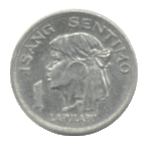


Lapulapu is regarded, retroactively, as the first Filipino hero.[40][41] The government erected a statue in his honor on Mactan Island and renamed the town of Opon in Cebu to Lapu-Lapu City. A large statue of him, donated by South Korea, stands in the middle of Agrifina Circle in Rizal Park in Manila, replacing a fountain and rollerskating rink. Lapulapu appears on the official seal of the Philippine National Police.[42] His face was used as the main design on the 1-centavo coin that was circulated in the Philippines from 1967 to 1974.[43]
According to local legend, Lapulapu never died but was turned into stone, and has since then been guarding the seas of Mactan. Fishermen in the island city would throw coins at a stone shaped like a man as a way of asking for permission to fish in the monarch’s territory.[44] Another urban legend concerns the statue of Lapulapu erected at the center of the town plaza. The statue faced the old city hall, where mayors used to hold office; Lapulapu was shown with a crossbow in the stance of shooting an enemy. Superstitious citizens proposed to replace this crossbow with a sword, after three consecutive mayors of the city each died of heart attack.[44]
In the United States, a street in the South of Market neighborhood of San Francisco, California is named after Lapulapu.[45] That street and others in the immediate neighborhood were renamed by the San Francisco Board of Supervisors with names derived from historical Filipino heroes on August 31, 1979.[46]
During the First Regular Season of the 14th Congress of the Philippines, Senator Richard Gordon introduced a bill proposing to declare April 27 as an official Philippine national holiday to be known as Adlaw ni Lapu-Lapu, (Cebuano, "Day of Lapu-Lapu").[47]
On April 27, 2017, President Rodrigo Duterte declared April 27 (the date when Battle of Mactan happened) as Lapu-Lapu Day for honoring as the first hero in the country who defeated foreign rule.[48][49] Duterte also signed Executive Order No. 17 creating the Order of Lapu-Lapu which recognizes the services of government workers and private citizens in relation to the campaigns and advocacies of the President.[50]
In popular culture
- Portrayed by Mario Montenegro in the 1955 film Lapu-Lapu.[51]
- Portrayed by Calvin Millado in the 1995 children's educational series Bayani.
- Portrayed by Lito Lapid in the 2002 film Lapu-Lapu.[52]
- He is a playable character in the mobile game Mobile Legends: Bang Bang.[53]
Shrine
The Lapu-Lapu shrine is a 20 metres (66 ft) bronze statue in Punta Engaño, Lapu-Lapu, Cebu, Philippines.[54]
 Mactan Shrine entrance
Mactan Shrine entrance Plaque recounting the defense of Mactan
Plaque recounting the defense of Mactan Plaque recounting Magellan's death
Plaque recounting Magellan's death
Notes
- Including what Pigafetta described as a "large cutlass", which was probably the two-handed kampilan
- Bangkaw, a light spear weapon that can be thrown. It is actually made of fire-hardened rattan, which superficially resembles bamboo, and is usually tipped with metal heads.
- Cognates include the modern Cebuano words sugba ("to grill"), subu ("to forge"), sug-ang ("to cook [over an open fire]"), and sugnod ("to burn" or "firewood")
- Sea raids and piracy (mangayaw) for slaves and plunder was not unique to the Moros, but widely practiced among other pre-Hispanic Filipino thalassocracies, including the Cebuanos. See Timawa
References
- "Mangubat". Philippine Armorial. Retrieved January 13, 2020.
- ABS-CBN News (May 1, 2019). "It's Lapulapu: Gov't committee weighs in on correct spelling of Filipino hero's name". ABS-CBN News. Manila: ABS-CBN Corporation. Retrieved March 24, 2020.
- Mendoza, Norman (November 14, 2019). "NQC: Lapulapu (without the hyphen) is Mactan ruler's name". Cebu Daily News. Lapu-Lapu City, Philippines. Retrieved March 24, 2020.
- Alipon, Joworski (November 14, 2019). "National Historical Commission to improve Lapulapu monument in Cebu". ABS-CBN News. Cebu City: ABS-CBN Corporation. Retrieved March 24, 2020.
- John Pinkerton (1812). "Pigafetta's Voyage Round the World". A general collection of the best and most interesting voyages and travels in all parts of the world: many of which are now first translated into English; digested on a new plan. Longman, Hurst, Rees, and Orme. p. 344.
- Antonio de Morga (1559–1636) annotations by José Rizal (1890). Sucesos de las islas Filipinas por el doctor Antonio de Morga, obra publicada en Méjico el an̄o de 1609. Nuevamente sacada à luz y anotada por José Rizal y precedida de un prólogo del prof. Fernando Blumentritt. Garnier hnos. p. 4.
- William Henry Scott (1994). Barangay: sixteenth-century Philippine culture and society. Ateneo de Manila University Press. ISBN 9789715501354.
- Albert P. Blaustein; Jay A. Sigler; Benjamin R. Beede (1977). "Republic of the Philippines: Cavite Declaration of June 12, 1898". Independence Documents of the World, Vol. 2. Oceana Publications. p. 567. ISBN 0379007959.
- Celestino C. Macachor (2011). "Searching for Kali in the Indigenous Chronicles of Jovito Abellana". Rapid Journal. 10 (2). Archived from the original on July 3, 2012.
- "The Death of Magellan, 1521". www.eyewitnesstohistory.com.
- Ocampo, Ambeth (April 25, 2018). "Lapu-Lapu, national hero". Inquirer.net. INQUIRER.net. Retrieved June 27, 2019.
- E. P. Patanñe (1996). The Philippines in the 6th to 16th Centuries. LSA Press, Inc. p. 175. ISBN 9789719166603.
- M.C. Halili (2004). Philippine History. Rex Bookstore, Inc. p. 74. ISBN 9789712339349.
- "Mariano Ponce". Provincial Government of Bulacan, Philippines. 2007. Retrieved July 9, 2012.
- Acta de la proclamación de la independencia del pueblo Filipino (in English and Spanish) from Wikisource.
- "In the nearby satellite island of Opong, Datu Mangal ruled the Sibuanons there and later his son succeeded him, rising in power and popularity. This legendary successor to Mangal was Lapu-Lapu. There had been many versions, even myths surrounding Lapu-Lapu’s origin." John Kingsley Pangan, Church of the Far East (Makati: St. Pauls, 2016), 68
- Donald F. Lach (1994). Asia in the Making of Europe, Volume I: The Century of Discovery. University of Chicago Press. pp. 175, 635–638. ISBN 9780226467320.
- Nowell, Charles E. (1962). Magellan’s Voyage Around the World: Three Contemporary Accounts. Northwestern University Press.
- Pigafetta, Antonio (1874), Lord Stanley of Alderley (ed.), The First Voyage Round the World by Magellan and other documents, p. 201
- Agoncillo, Teodoro A. (1990), History of the Filipino People (Eighth ed.), University of the Philippines, ISBN 971-8711-06-6
- Zaide, Sonia M. (2006), The Philippines: A Unique Nation, All-Nations Publishing Co. Inc., Quezon City, ISBN 971-642-071-4.
- Zaide, Gregorio F. (1939), Philippine History and Civilization, Philippine Education Co.
- Scott, William Henry (1985), Cracks in the parchment curtain and other essays in Philippine history, New Day Publishers, ISBN 978-971-10-0074-5
- Williams, Patrick (2009), "Philip II, the Philippines, and the Hispanic World", in Ramírez, Dámaso de Lario (ed.), Re-shaping the World: Philip II of Spain and His Time (illustrated ed.), Ateneo de Manila University Press, ISBN 978-971-550-556-7
- Frank "Sulaiman" Tucci (2009). The Old Muslim's Opinions: A Year of Filipino Newspaper Columns. iUniverse. p. 41. ISBN 9781440183430.
- Yusuf Morales. "Looking at the other Lost Moro Kingdoms". Scribd. Retrieved December 21, 2013.
- "Silat An-Nur: Lapu Lapu ... Master of Silatan". June 3, 2007.
- Farish A. Noor (2012). Islam on the Move: The Tablighi Jama'at in Southeast Asia. Amsterdam University Press. p. 240.
- "Boljoon excavation shows gold jewelry, China trade - INQUIRER.net, Philippine News for Filipinos". June 8, 2008. Archived from the original on June 8, 2008.
- J.P. Sanger (1905). "History of the Population". Census of the Philippine Islands, Volume I: Geography, History, and Population. Washington, D.C.: United States Bureau of the Census. p. 414. ISBN 9789712321429.
- Antonio Pigafetta. MS. ca. 1525, of events of 1519-1522 (1906). "Primo viaggio intorno al mondo". In Emma Helen Blair & James Alexander Robertson (ed.). The Philippine Islands, 1493-1803; explorations by early navigators, descriptions of the islands and their peoples, their history and records of the Catholic missions, as related in contemporaneous books and manuscripts, showing the political, economic, commercial and religious conditions of those islands from their earliest relations with European nations to the beginning of the nineteenth century. The Arthur H. Clark Co. p. 161.
- Carolyn Brewer (2004). Shamanism, Catholicism, and Gender Relations in Colonial Philippines, 1521-1685. Ashgate Publishing, Ltd. p. 102. ISBN 9780754634379.
- "In the nearby satellite island of Opong, Datu Mangal ruled the Sibuanons there and later his son succeeded him, rising in power and popularity. This legendary successor to Mangal was Lapu-lapu. There had been many versions, even myths surrounding Lapu-lapu’s origin. One account tells that many years before Magellan’s arrival, a man called Dimantag traveling from Borneo reached to shores of Sibu. He asked Rajah Humabon for a place to settle. The wanderer was given the nearby Opong island, though Dimantag primarily preferred to settle in Mandawili (modern-day Mandaue). Ages passed, Dimantag rose to power in Opong and became known by Sibuanons as Sri Lapu-lapu (Cilapulapu by the Spaniards). Farther south in Mindanao, the annals of Moro history made Lapu-lapu a Muslim. He was said to have an allegiance with the Sultan of Sulu. However, direct evidence such as accounts of Pigafetta and the ancient Sugbuanon oral tradition did not indicate Lapu-lapu as a Muslim but a Visayan animist." John Kingsley Pangan, Church of the Far East (Makati: St. Pauls, 2016), 68.
- Paul A. Rodell (2002). Culture and Customs of the Philippines. Greenwood Publishing Group. p. 50. ISBN 9780313304156.
- Sebastian Sta. Cruz Serag (1997). The Remnants of the Great Ilonggo Nation. Rex Bookstore, Inc. p. 95. ISBN 9789712321429.
- Raquel A.G. Reyes; William G. Clarence-Smith (2012). Sexual Diversity in Asia, c. 600 - 1950. Routledge. p. 130. ISBN 9781136297212.
- Jeanne Nagle (2011). Why People Get Tattoos and Other Body Art. The Rosen Publishing Group. p. 37. ISBN 9781448846177.
- Gregorio F. Zaide (2006). "Filipinos before the Spanish Conquest Possessed a Well-Ordered and Well-Thought-Out Religion". In Tanya Storch (ed.). Religions and Missionaries Around the Pacific, 1500-1900. Ashgate Publishing, Ltd. pp. 34–35. ISBN 9780754606673.
- James A. Boon (1990). Affinities and Extremes: Crisscrossing the Bittersweet Ethnology of East Indies History, Hindu-Balinese Culture, and Indo-European Allure. University of Chicago Press. p. 12. ISBN 9780226064635.
- Zaide, Sonia M. (1994). The Philippines: A Unique Nation. All Nations Publishing Co., Inc. pp. 83–84. ISBN 971-642-005-6.
- de Guzman, Maria O. (1967). The Filipino Heroes. National Bookstore, Inc. p. 58. ISBN 971-08-2987-4.
- "PNP Seal Symbolism". Archived from the original on March 16, 2008. Retrieved June 9, 2008.
- "American Numismatic Society". Retrieved June 10, 2008.
- "Battle of Mactan: history and myth".
- "Lapu Lapu Street in San Francisco". Retrieved August 13, 2008.
- "07/09/2012: THE PHILIPPINES IN SAN FRANCISCO". The Philippine Consulate General in San Francisco. FILIPINO HEROES AND NAMES : THE STREETS OF SAN FRANCISCO.
- Gordon, Richard J. "An Act to declare April 27 of every year as a special non-working holiday throughout the country to commemorate the victory of Lapu-Lapu and his men over the Spaniards led by Fernando Magallanes..." (PDF). Retrieved July 11, 2008.
- Kabiling, Genalyn (April 27, 2017). "April 27 declared as Lapu-Lapu Day". Manila Bulletin. Retrieved May 22, 2017.
- Romero, Alexis (April 27, 2017). "'Hero' Lapu-Lapu gets special day". The Philippine Star. Retrieved May 22, 2017.
- "Executive Order No. 17, s. 2017 | GOVPH". Official Gazette of the Republic of the Philippines. Retrieved June 10, 2020.
- "Lapu-Lapu (1955)". Retrieved June 10, 2008.
- "Lapu-Lapu (2002)". Retrieved June 10, 2008.
- "Mobile Legends: Menilik Sejarah Terciptanya Karakter GatotKaca di Game yang Sedang Hits!". Okezone Techno (in Indonesian). July 26, 2017.
- "Lapu-Lapu Monument also called Mactan Shrine". Cebu City. Retrieved April 1, 2015.
Further reading
- Agoncillo, Teodoro A. "Magellan and Lapu-Lapu". Fookien Times Yearbook, 1965, p. 634
- Alcina, Francisco, Historia de las Islas e Indios de Bisaya, MS 1668
- Correa, Gaspar, Lendas de India, Vol. 2, p. 630
- Cruz, Gemma, "Making Little Hero of Maktan"
- Estabaya, D. M., "445 Years of Lapu-lapu", Weekly nation 1: 26-27, April 25, 1966
- Pigafetta, Antonio, Primo Viaje en Torno al Globo Terraqueo, Corredato di Notte de Carlo Amoteti, Milano, 1800
External links
| Wikimedia Commons has media related to Lapu-Lapu. |